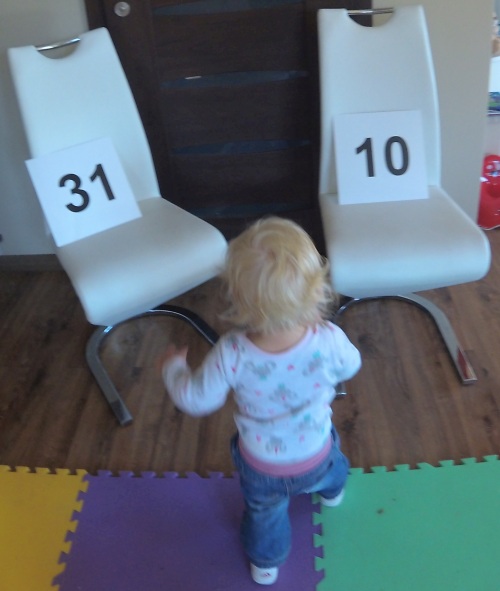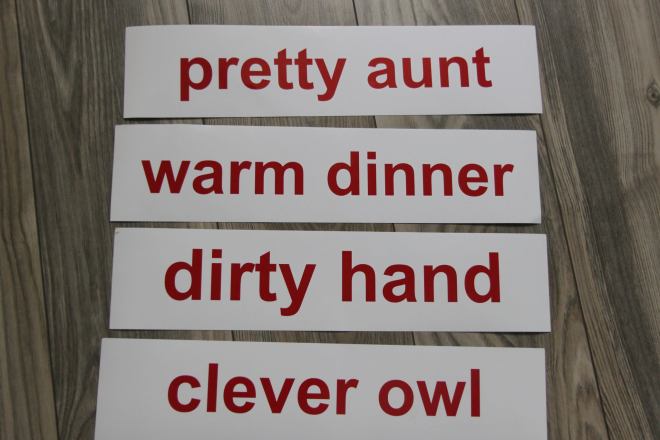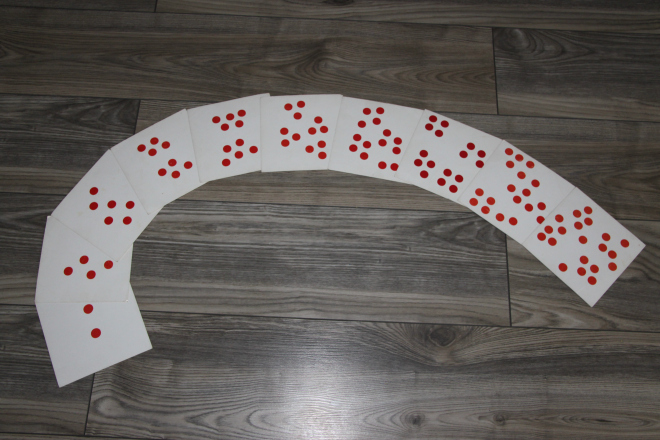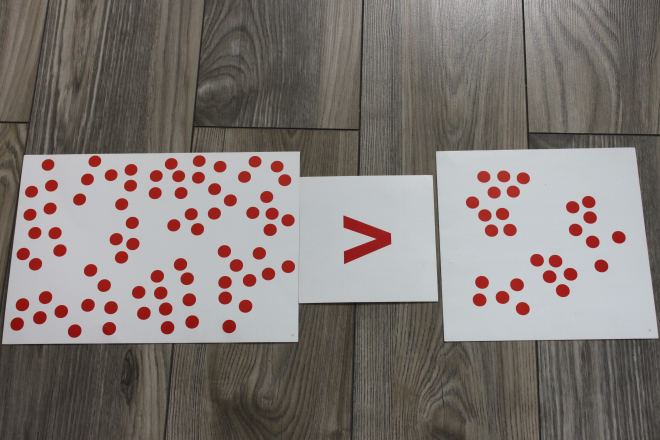
THE DOMAN METHOD AND TESTING
However it may sound, Glenn Doman in all his books I mentioned in the Must-have section, states clearly that we shouldn’t test our children to check if they have acquired the material we presented or not. According to him, when we test them their eagerness to learn is impeded. He uses a beautiful metaphor to illustrate this: “To teach a child is to give him a delightful gift. To test him is to demand payment in advance.” This means we push a child before he or she is able and willing to show us how much he or she knows. Indeed, the fact that we shouldn’t put any pressure on our child should be uppermost in our minds.
Moreover, testing as understood by adults aims at discovering what somebody doesn’t know. In case of small children we have to emphasize the things they already know. Therefore, we shouldn’t ask: “What does it say?” even if a kid can pronounce a given word. Picking up one card out of many that have been lain on the floor is also out of the question. I admit we sometimes have plenty of word cards on the floor but we just play with them.
Virtually, we can do without checking our babies’ knowledge. The problem is that we, adults, need this. It is extremely difficult for us to just trust our children completely and teach them through play and never test them. I have to admit it was hard even for me not to check up on Maja’s progress. However, we have had the whole weeks with presentations only when she had to the opportunity to see new words or quantities or numerals without being tested because she wasn’t willing to choose the correct answer. I have never pushed her to demonstrate what she knows. I have never put any pressure on her. If she is willing and only if she is willing to show me what she knows, I test her in accordance with Doman’s suggestions.
PROBLEM-SOLVING OPPORTUNITIES INSTEAD OF TESTING
Doman says that a wise parent does not test his or her child but that he or she provides something that Doman calls “problem-solving opportunities” for a child. This means we give a child just two cards to choose. We ask for example: “Where is the dog?” in any language we teach to our baby and she or he is supposed to choose the card with a word “dog.” What if a child chooses the other card? Don’t worry and continue reading this post.
In the main picture for this article you can see the problem-solving opportunity for the question: “Where is number 10”? If a child chooses the correct card, we go over the moon, we kiss and praise our baby. We can also read the other one. If our baby chooses the wrong one we calmly thank him or her for making this effort and we tell him or her that this is not this one but the other one. We say it without a shadow of negative emotions. I sometimes monkey around a bit with the other card – the proper one. We have fun even if Maja pick up the wrong answer.
It is important that we do not look for and do not focus on gaps in the knowledge of our little one. Our baby knows that no matter what answer he or she gives we love and appreciate him or her just for the effort he or she has made to choose the right card. If a child doesn’t want to make any choice we do this instead of him or her and we read its content aloud. It seems obvious that if our baby constantly refuses to choose, it means that he or she doesn’t enjoy doing it. Knowing that we don’t really need to give these problem-solving opportunities maybe it will be easier for us to have a break from them. It is better to focus on presentations of new material: words, equations, quantities or numerals or whatever we are doing. We can try problem-solving opportunities in a few weeks again.
I often showed my daughter two cards to choose which I mentioned it in my first blog entry. Nevertheless, we have had an almost 2-month break because Maja completely lost her interest in choosing. After 2 or 3 days without any action on her part which she was supposed to take when I presented her two cards, I decided to give it a longer break. We have come back to this and …. she wants more saying “more” in English.
Doman says children are different and I agree with him. Some like choosing and love these problem-solving opportunities but there are also those who don’t like them which they demonstrate by constantly choosing the wrong card or by showing no reaction at all. We have to follow our instincts and in a way guess to what category our child belongs. If our child doesn’t like being tested even by means of problem-solving opportunities we have to stop asking him or her to choose. We need to trust our baby completely and believe strongly that he or she acquires knowledge like a sponge and checking his or her progress is not necessary. I have read somewhere quite recently that up to the age of three we have to focus on the input only. The output is from the age of three. Before that we can’t push our kid to show us anything.
FUN WITH CARDS
There are some alternatives to problem-solving opportunities. I haven’t tried them, though, because my Maja is just 18 months old. Doman suggests a game for the whole family. We put 9 cards with words on the floor and while playing we follow the rules for Bingo: each member of the family puts something e.g. a poker chip (in our case we will probably use bottle caps as in one step in maths which I mentioned here) on the card which is called out. After some time we can increase the number of words. Of course, we are supposed to use the words which have already been retired which means that they appeared 3 times daily for 5 consecutive days in our sessions.
We can also place cards with pictures of animals on the floor and search for an animal which matches the word on the card shown. We have to remember at all times that this testing is only for us – adults. Doman’s approach is that a child is much more interested in learning new information (words, quantities or numbers) that in going back to the cards that he or she has already seen a few times.
QUESTIONS AND OUR CHILDREN’S AGE
Because of my baby’s age – 18 months, I ask similar questions that I have mentioned before. However, we can make them more complex and thus, more interesting when a child is a bit older. When showing the cards to a 2-year-old instead of asking: “Where’s the apple?” our question may be: “What have you just eaten?” With a 3-year-old we can ask: “What fruit is it: red, round and sweet?” When our little one is 4 years old we can go crazy and stir his or her curiosity with questions such as “Which of these two fruits grow in Africa?” if we know a child has enough knowledge about the world to answer it. In any case we never ask: “What does it say?” when presenting a word card. This question is too abstract for such small children let alone toddlers.
FEW WORDS ABOUT PRAISING A CHILD
I think we can’t overdo with praising our child although I sometimes wonder if I don’t that too often. The more sincere approval and the more praising, the better.
After each card presentation we are supposed to praise our babies loudly kissing them and telling them how clever they are and whatever positive feedback comes to our minds. It is the same in case of problem-solving opportunities when a child chooses the correct card. If the chosen card is wrong we just thank our baby for choosing. If a kid doesn’t take any action we don’t praise him or her at all but we don’t criticise him or her either. We must be completely calm and don’t show any negative feelings or thoughts. We just read what it says on the right card and we move on.
As you can read here there was a time when I had 18 sessions of whole-word reading programme combined with maths programme daily. She heard the joyful word “bravo” many times each day. She has even started using it by herself. When she succeeds in doing something and she thinks she deserves to be praised she claps her hands and cheerfully says “bravo.” I have decided to replace it with “awesome” quite recently to teach her more positive words in English. In addition to such words as “bravo” or “awesome” I pay her various compliments e.g. how clever she is. It is completely natural and spontaneous for me to praise my baby. It is not as natural for daddy and I often have to nudge him shortly after he has presented his cards to say something positive at the end of each session. It is the same in case of my mum and others.
BRAGGING ABOUT A BABY
Almost every parent needs to brag about what his or her child can do. I admit I am the same. As I mentioned before Doman puts an emphasis on the fact that all tests are for adults and that the kids don’t like to be tested. It is not only about maths or reading. I think I have never asked my baby to choose the right card outside home. However, during a family party, I wanted her to show where her eyes, nose and mouth etc. are because I was sure she could do it. When asked to do this she didn’t take any action at all. My mother-in-law asked her the same in Polish and ….nothing happened. I think there were just too many new faces, too many people and my baby was too shy.
On other occasion, bragging about my baby worked. My friends visited me. Maja demonstrated great interest in the cards while one of my them presented her 5 words in Polish. She was also eager to pick up the right card from the floor when give a problem-solving opportunity. My friends were amazed. One even said that Maja is brighter than kids in the kindergarten where she teaches.
I ask Maja to shake hands with any new person who comes to our house. She often says “bye, bye” when this person goes out. Quite recently she replied to “What’s your name?” question in presence of one of my students. I was so proud of my daughter.
I mentioned recently that we have a video of Maja doing some sessions of our reading programme which I needed to take part in one of the contests. One day in the morning, Maja repeated all the words her daddy presented her. I thought that maybe if my husband tried to have a similar session at the same time next day I would be able to record it. I wanted to add that video to the ones we had already had. The following day Maja was focused on the cards but she didn’t say a word. You will see this fragment soon.
Here is a story found somewhere in the virtual world: mum was bragging about her child saying he could do so many things. At the same time she was complaining that she had no way of presenting his skills because he didn’t want to show off when asked to do so. Then, she learned that behind her back her son was demonstrating everything she was talking about. As you can see, bragging has its fifty shades.
Have you found my experience useful? If yes, share with others. How about you? Are you able to trust your child and focus on teaching him or her without checking his or her knowledge? I would be really delighted if you leave a comment and share your experience and ideas.
You are invited to follow Facebook fanpage and to subscribe for this blog.
I have created a Facebook group for parents doing Doman as I haven’t found any. This is just the beginning but I hope there will be more and more of us soon and that we will share our experience with one another.


